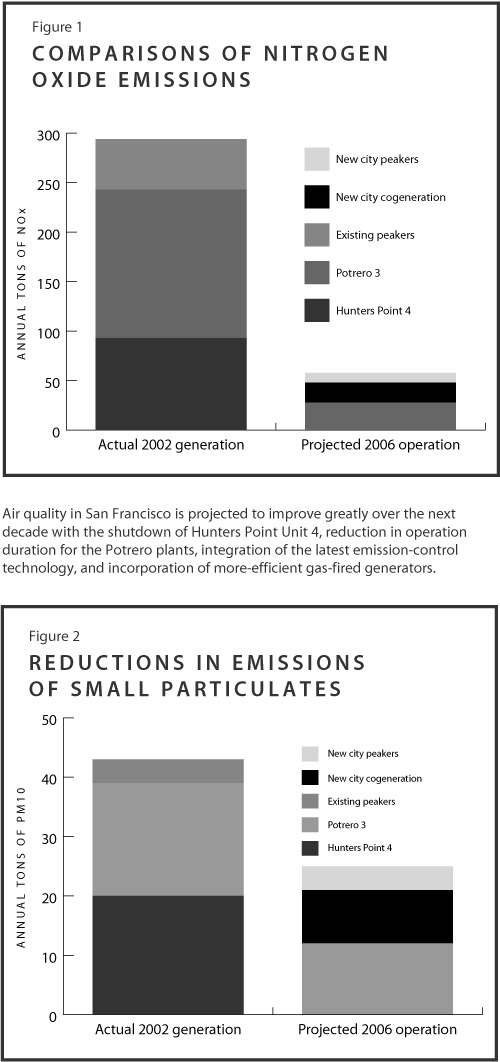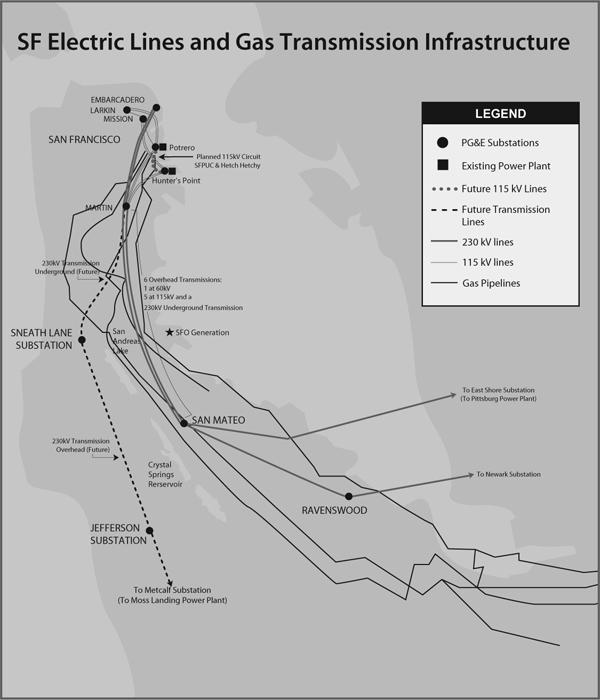Two years after the peak of the state's energy crisis, San Francisco's energy future is still far from clear. San Francisco's long-term economic and environmental well-being is vulnerable to an aging and inadequate electric power infrastructure. Key decisions about electrical generation and the upgrading of the regional high-voltage transmission system need to be made over the next several years. These decisions will require the investment of hundreds of millions dollars.
Last year the Board of Supervisors andMayor adopted a ten-year Electricity Resource Plan developed by the San Francisco Public Utilities Commission and the Department of the Environment (see www.sfgov.org/sfenvironment/aboutus/energy/policy.htm). The Plan presented a strategy for closing the Hunters Point power plant by 2005, phasing out the Potrero power plant and putting San Francisco on the path to using energy resources in a sustainable manner.
Closing the Hunters Point Power Plant
San Francisco's two power stations, located at Hunters Point and Potrero in the southeastern part of the city, are currently used to meet San Francisco's peak demand for electricity and to de-congest bottlenecks occurring on the transmission system in the greater Bay Area. The principal power plants at these locations were built in 1958 and 1965 and need to be retired. PG&E, which owns the Hunters Point power station, has agreed to close the plant permanently when it is no longer needed for local and regional electric reliability.
The quasi-public agency with the authority to make the decision that the Hunters Point Power Plant is no longer needed is the California Independent System Operator (ISO). The ISO, which runs the California electric grid on a day-to-day basis, has recently set forth conditions which, when met, will allow the closure of the larger of the two power plants at Hunters Point. Those conditions include the installation of new electrical generation in San Francisco equivalent in capacity to the Hunters Point plant and the completion of two transmission projects.
The most likely source of new generation in San Francisco are four gas-fired combustion turbines that the San Francisco Public Utilities Commission has obtained as part of a legal settlement. Those combustion turbines have the capability of producing 185 megawatts of electricity (see "San Francisco Going Solar" on page 9). The ISO has indicated that if all four of these combustion turbine-generators were connected to the San Francisco grid, there would be enough replacement power to close the large power plant at Hunters Point. One of the needed transmission projects is a two-mile underground cable that will connect the electrical substations located at the Potrero and Hunters Point power plants and allow power to flow to all parts of the city once the Hunters Point plant is closed. PG&E and the San Francisco Public Utilities Commission are cooperating on the planning for this transmission line to take advantage of conduits that have already been placed underground as part of the Third Street Light Rail project. The other transmission project involves upgrading an overhead line from the City of San Mateo to the San Francisco county line. PG&E is expected to get approval from the state to begin this project in the near future.
Phasing Out the Potrero Power Plant
The Potrero power station consists of one large power plant that runs on natural gas (Potrero Unit 3) and three smaller peaking power plants that use diesel fuel. Potrero Unit 3 is San Francisco's largest source of nitrogen oxide (NOx) emissions, one of the leading causes of smog. At its peak output of 207 megawatts, Potrero Unit 3 emits 80 parts per million of NOx. The plant's owner, Mirant Potrero LLC, has been able to operate the plant in compliance with local air quality regulations by averaging its emissions with other power plants it owns in the Bay Area. However, beginning in 2004, meeting air quality requirements will be more difficult for Mirant. By 2005, Mirant will have to lower emissions at Potrero 3 to 15 parts per million to meet the more stringent standards.
Mirant has proposed to retrofit Potrero Unit 3 in 2005 using the best emissions control technology that is commercially available (selected catalytic reduction). This retrofit would bring the plant into compliance with regional air quality standards. The cost of the retrofit is estimated to be around $35 million. Mirant has received permission from the ISO to recover that investment plus a reasonable rate of return over five years. The retrofit of Potrero Unit 3 means that it is likely, although not guaranteed, that it will continue to operate through 2009 and possibly longer.

The three 27-year-old diesel-fired peaking power plants at Potrero have no emission controls at all and for each megawatt hour they produce, they are the most polluting power plants in San Francisco. As such, the Bay Area Air Quality Management District has limited the use of these peakers to 10 percent of the hours in a year. Typically, these peaking plants are used during periods of peak demand when either Hunters Point Unit 4 or Potrero Unit 3 are not available for operation. The siting of the city-owned combustion turbine-generators will significantly reduce the need to operate these older peakers.
The Electricity Resource Plan envisioned the closure of Potrero Unit 3 through the combination of new in-city generation, load reduction through energy efficiency measures, and completion of a new 28-mile transmission line PG&E is proposing to build from Woodside in San Mateo County to the San Francisco County border. This transmission line would improve the reliability of electric service in San Francisco and allow power to be imported from other parts of the state, potentially lowering the cost of electricity.
With the retrofit of Potrero Unit 3 scheduled for 2005, it now seems unlikely that its closure will occur in the immediate future. However, the combination of the city-owned combustion turbine generators and the new PG&E two-mile transmission line should eliminate the need for all the diesel-fired peakers located in San Francisco. Their closure ultimately depends on an ISO decision not to renew contracts that require that these plants be made available for ISO dispatch.

Long-term Power Portfolio Options
By 2012 it is reasonable to expect that all of the existing power plants in San Francisco will be retired. To achieve the Electricity Resource Plan goals of sustainability, environmental equity, and greenhouse gas reductions, decision-makers in the public and private sectors will have to take advantage of opportunities to replace aging energy infrastructure with state-of-the-art technology.
To achieve these goals, San Francisco will have to rely increasingly on smaller-scale energy technologies that can be sited inside buildings and on rooftops. Solar power will have an increasing role in meeting summer peak demand but will need to be supplemented by other modular technologies that can produce power at other times of the day and year. Fuels cells and microturbines for small-scale cogeneration systems are expected to be technically feasible by 2012. However, their economic feasibility will require dramatic cost reductions and improvements in performance to avoid raising the costs of electricity. Rapid improvements in the cost and performance of distributed generation technologies could permit the retirement of the city-owned combustion turbines by 2020 or even earlier.
Growth in demand for electric services will continue to drive the need for more power generation. To meet both reliability and environmental needs, in-city generation must be highly efficient and low in emissions. Larger installations with needs for steam could use high-temperature fuel cells such as molten carbonate or solid oxide technologies, while smaller installations with need for hot water would likely use proton exchange membrane fuel cell technology.
In 2012 and through 2020, San Franciscans will continue to import the bulk of the electricity they consume. To meet the goal of reducing greenhouse gases, an increasing proportion of the imported power will need to come from renewable energy sources. State law requires more than twice as much electricity come from non-hydro renewable energy sources by 2017. Currently, the most cost-effective renewable energy technologies for meeting those requirements are wind, landfill gas, and geothermal.
Technologies in which significant improvements are expected in the next 10 years include concentrating solar power, tidal power, wave power and biomass gasification for combined cycle power plants. San Francisco will need to monitor developments in these technologies and consider when appropriate quantities could be added to its resource portfolio.